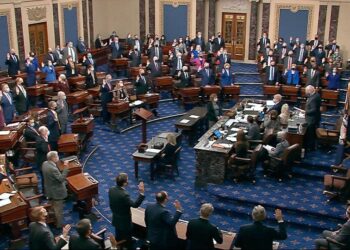In a notable progress for South Korea’s social security landscape,the country’s major political parties have come together to reach a consensus on much-needed pension reform. This collective agreement marks a pivotal moment in addressing the financial sustainability of the nation’s pension system, wich has faced mounting pressures due to an aging population and prolonged economic challenges.Anchored in collaborative discussions, the proposed reforms aim to enhance the viability of pension benefits while balancing the fiscal responsibilities of the government. As stakeholders assess the implications of this agreement, the move is seen as a crucial step toward safeguarding the financial future of millions of South Koreans who rely on these essential benefits.This article delves into the details of the reform consensus, exploring its potential impact on citizens and the broader economic landscape.
South Korea’s Political Landscape Shifts with Pension Reform Consensus

In a significant shift within the political framework of South Korea, key parties have set aside their differences to forge a consensus on pension reform, a move crucial for addressing the nation’s aging population and fiscal sustainability.The agreement comes after extensive negotiations,where leaders prioritized social security over partisan agendas. This collaboration signals a potential for more shared initiatives in the future, as party leaders recognize the pressing need for reforms that can withstand demographic challenges.The resulting measures are expected to not only stabilize pensions but also enhance public trust in governmental institutions.
The reform framework highlights several key components that were agreed upon, including:
- Increased Contributions: A gradual rise in contributions from both employees and employers, aimed at bolstering the pension fund.
- Retirement Age Adjustment: A planned increase in the retirement age to align with life expectancy improvements.
- Benefit Adjustments: A revision of benefit calculations to reflect current economic conditions and ensure fair payouts.
The ongoing discussions present an opportunity for broader collaboration beyond just pension reform. Political analysts suggest that if accomplished, this consensus could lead to similar dialogues on other critical issues like healthcare, veterans’ benefits, and youth unemployment, marking a progressive era in South Korea’s governance.
Key Features of the Newly agreed Pension Policy in South Korea

The newly agreed pension policy in South Korea introduces a range of transformative features aimed at enhancing the sustainability and equity of the pension system. Key components include:
- Adjusted Contribution Rates: the policy revises the contribution rates for both employees and employers, ensuring a more balanced financial duty.
- Retirement Age Versatility: It offers options for extending the retirement age, allowing individuals to choose between early retirement and continued employment for increased benefits.
- Increased Benefits for Low-Income Seniors: A new tiered benefit structure is implemented, providing enhanced monthly payments for retirees in lower income brackets.
- Pension Fund Diversification: Investments made by pension funds will now include a wider array of assets, potentially increasing returns and bolstering fund resilience.
To create transparency and public trust, the policy also emphasizes independent oversight and regular audits of pension funds. A new,dedicated body will be established to monitor fund management practices and ensure compliance with the updated regulations.The following table summarizes the projected impacts of the reform:
| Impact Category | Projected Change |
|---|---|
| Employee Contributions | +2% over 5 years |
| Pension Fund Returns | +15% projected growth |
| Retirement Age Options | Extended by up to 5 years |
| Support for Low-Income Seniors | Additional ₩300,000 monthly benefit |
Implications of Pension Reform for south Korea’s Aging Population

The recent agreement among South Korea’s political parties on pension reform is poised to considerably impact the nation’s aging population. as the demographic landscape shifts, with a growing number of individuals aged 65 and over, the reform seeks to ensure financial sustainability for future retirees. The new measures aim to address pressing concerns regarding the adequacy of the pension system in light of increasing life expectancy and declining birth rates. some of the primary implications include:
- Increased pension Benefits: Adjustments to benefit structures may provide greater financial security for retirees, alleviating the risk of poverty among the elderly.
- Funding Models: Discussions surrounding diversified funding sources could help stabilize the pension system against economic fluctuations.
- Workplace Participation: reforms may encourage older individuals to remain in the workforce longer, fostering a culture of extended professional engagement.
The success of these reforms will hinge on effective implementation strategies and widespread public acceptance. Policymakers must address the concerns of younger demographics,who may be apprehensive about contributing to a system that appears skewed toward the aging population. considerations will need to be made regarding the sustainability of pension funds, as highlighted in the table below:
| Factor | Impact on Pension System |
|---|---|
| Population Aging | Increased demand for pensions affects funding needs. |
| life Expectancy | Longer lifespans necessitate higher benefit contributions. |
| Birth Rate Decline | Fewer working-age individuals may strain the funding pool. |
Economic impact: How Pension Changes Will shape future Growth

The recent agreement among South Korea’s political parties concerning pension reform heralds significant economic changes that could influence future growth trajectories. As aging populations strain public resources, these reforms aim to ensure the sustainability of pension systems while simultaneously addressing the financial needs of retirees. Notably, this shift could lead to a more stable economic habitat by reinforcing consumer confidence and increasing spending power among senior citizens. The expected benefits are multifaceted:
- Increased disposable income: Enhanced pension schemes mean more funds available for retirees, which could fuel local economies.
- Encouragement for workforce participation: Reformed benefits may incentivize older citizens to remain in the job market longer.
- Boost in savings rates: With a more secure financial future,individuals may feel encouraged to save,stimulating further investment.
On the flip side, the economic impact also depends heavily on the execution of these reforms. A poorly managed transition could lead to disruptions in existing economic frameworks. Policymakers must be vigilant, balancing the immediate fiscal implications with long-term sustainability. To effectively visualize the potential shifts in the economy, consider the following table showing projected impacts:
| Impact area | Short-Term effects | long-Term Effects |
|---|---|---|
| Pension Fund Stability | Increased public support | Long-term sustainability |
| consumer Spending | Immediate economic boost | Steady growth in demand |
| Employment Rates | Potential fluctuations | Stable employment for seniors |
Recommendations for Successful Implementation of Pension Reforms

To ensure the successful implementation of pension reforms, it is indeed crucial to establish a robust stakeholder engagement process. Engaging key stakeholders—including government officials, pension experts, and public representatives—will foster an environment of collaboration and transparency. This process can include:
- regular public forums to discuss proposed changes
- Surveys to gather feedback from different demographics
- Engagement with labor unions and employers
In addition, the reform strategy should incorporate clear communication frameworks. To maintain public trust and understanding around pension changes, information must be disseminated effectively. This can be accomplished through:
- Detailed informational campaigns outlining the benefits and implications of the reforms
- Utilizing multiple media platforms, including social media and community events
- Creating simplified informational materials that are accessible to all age groups
The Role of Public Engagement in Sustaining Pension Policy Stability

Public engagement plays a crucial role in maintaining the stability of pension policies, particularly as South korea navigates significant reforms. Broad involvement from various sectors of society—including citizens, advocacy groups, and industry stakeholders—ensures that the policies enacted resonate with the needs and expectations of the population. When the public is actively involved in discussions, it promotes transparency and accountability among policymakers, reducing the likelihood of conflicts or dissatisfaction that may undermine long-term stability.
Key elements of public engagement include:
- Informative Campaigns: Educating the public about proposed reforms helps demystify pension policies and fosters understanding and acceptance.
- consultative Processes: Engaging with communities through forums and surveys allows citizens to voice their concerns and suggestions, leading to more inclusive policy outcomes.
- Collaborative Partnerships: Building alliances with non-governmental organizations and professional groups can enhance the legitimacy of the reforms and contribute to shared investment in the system’s success.
| Engagement Strategies | Impact on Pension stability |
|---|---|
| Public Town Halls | Encourages open dialog and transparency. |
| Online Surveys | Gathers a broad range of opinions quickly. |
| Focus Groups | Delves into specific community concerns for tailored policies. |
In Summary
As South Korea navigates the complexities of its aging population and economic challenges, the recent consensus reached by the nation’s political parties on pension reform marks a significant step forward. This agreement not only reflects a commitment to social stability but also highlights the importance of collaborative governance in addressing critical issues that affect citizens’ livelihoods. The successful passage of these reforms will require vigilant oversight and ongoing dialogue among stakeholders to ensure that the proposed changes effectively respond to the diverse needs of South Korea’s citizens. As the nation moves ahead, the implications of this consensus will be closely watched, shaping the dialogues surrounding future policy initiatives and the welfare of its population.

![[Minute to Read] South Korea’s political parties reach consensus on pension reform – 조선일보](https://asia-news.biz/wp-content/uploads/2025/03/127550-minute-to-read-south-koreas-political-parties-reach-consensus-on-pension-reform-eca1b0ec84a0ec9dbcebb3b4-640x375.jpg)














